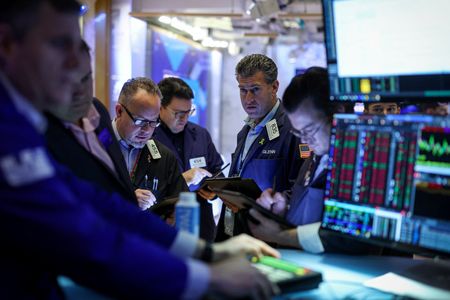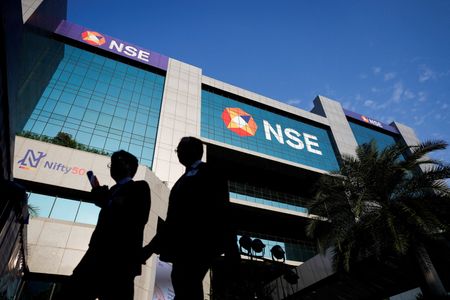(This Feb. 4 story has been refiled to reflect the day’s closing report)
By Stephen Culp
NEW YORK (Reuters) – U.S. stocks rallied on Tuesday, while gold reached new highs as global trade jitters kept investors guessing.
All three major U.S. stock indexes gained momentum after last-minute negotiations resulted in one-month reprieves on President Donald Trump’s 25% levies against Canada and Mexico.
But safe-haven investors continued to favor gold after a 10% tariff against China went into effect. That tariff prompted Beijing to announce its own retaliatory tariffs against U.S. energy exports and expand its control over the export of critical minerals.
China also warned Alphabet and other American firms of potential sanctions.
Contradicting earlier reports that he would speak with Chinese President Xi Jinping to diffuse trade tensions, Trump said he was in no hurry to have that conversation.
“The tariff news is back-and-forth and heightened uncertainty and yet the market seems to want to go up,” said Thomas Martin, senior portfolio manager at GLOBALT in Atlanta.
But Martin does not expect much to be resolved between Trump and Xi.
“I expect there to be more room for continued escalation, because I don’t think the Chinese government is going back down,” Martin added. “They’re still an enemy.”
Data showed U.S. job openings and factory orders both fell more than expected in December, pointing to some economic dampening, but not enough to convince the U.S. Federal Reserve to continue down its rate-cutting path anytime soon.
The Dow Jones Industrial Average rose 134.13 points, or 0.30%, to 44,556.04, the S&P 500 rose 43.31 points, or 0.72%, to 6,037.88 and the Nasdaq Composite rose 262.06 points, or 1.35%, to 19,654.02.
European shares ended a choppy session modestly higher as investor focus shifted to quarterly earnings reports, while anxieties over U.S. tariffs igniting a broader trade war were moved to the back burner.
MSCI’s gauge of stocks across the globe rose 7.89 points, or 0.92%, to 867.22.
The STOXX 600 index rose 0.22%, while Europe’s broad FTSEurofirst 300 index rose 4.51 points, or 0.21%.Emerging market stocks rose 20.62 points, or 1.92%, to 1,094.34. MSCI’s broadest index of Asia-Pacific shares outside Japan closed higher by 1.92%, to 575.27, while Japan’s Nikkei rose 278.28 points, or 0.72%, to 38,798.37.
U.S. 10-year Treasury yields dropped on Tuesday amid volatile trading, weighed by trade uncertainties.
The yield on benchmark U.S. 10-year notes fell 3 basis points to 4.513%, from 4.543% late on Monday.
The 30-year bond yield fell 2.4 basis points to 4.747% from 4.771% late on Monday.
The 2-year note yield, which typically moves in step with interest rate expectations for the Federal Reserve, fell 4.9 basis points to 4.216%, from 4.265% late on Monday.
The dollar lost ground after duties against Chinese goods took effect.
The dollar index, which measures the greenback against a basket of currencies including the yen and the euro,fell 0.57% to 107.96, with the euro up 0.37% at $1.0382.Against the Japanese yen, the dollar weakened 0.32% to154.27.
The Mexican peso < MXN=> weakened 0.8% versus the dollar at 20.507.
The Canadian dollar strengthened 0.74% versus the greenback to C$1.43 per dollar.
In cryptocurrencies, bitcoin fell 3.74% to $98,059.33. Ethereum declined 3.9% to $2,705.42.
Crude prices pared their losses after a U.S. official said Trump plans to restore his “maximum pressure” campaign on Iran, which would include driving its oil exports down to zero to stop Tehran from obtaining a nuclear weapon.
U.S. crude fell 0.63% to $72.70 per barrel, while Brent rose to $76.20 per barrel, up 0.32%.
Gold prices continued to rally, hitting fresh highs as investors flocked to the safe-haven metal.
Spot gold rose 1.05% to $2,842.99 an ounce. U.S. gold futures rose 0.66% to $2,852.60 an ounce.
(Reporting by Stephen Culp; Additional Reporting by Harry Robertson in London; Editing by Alexander Smith, Sandra Maler and Rod Nickel)










